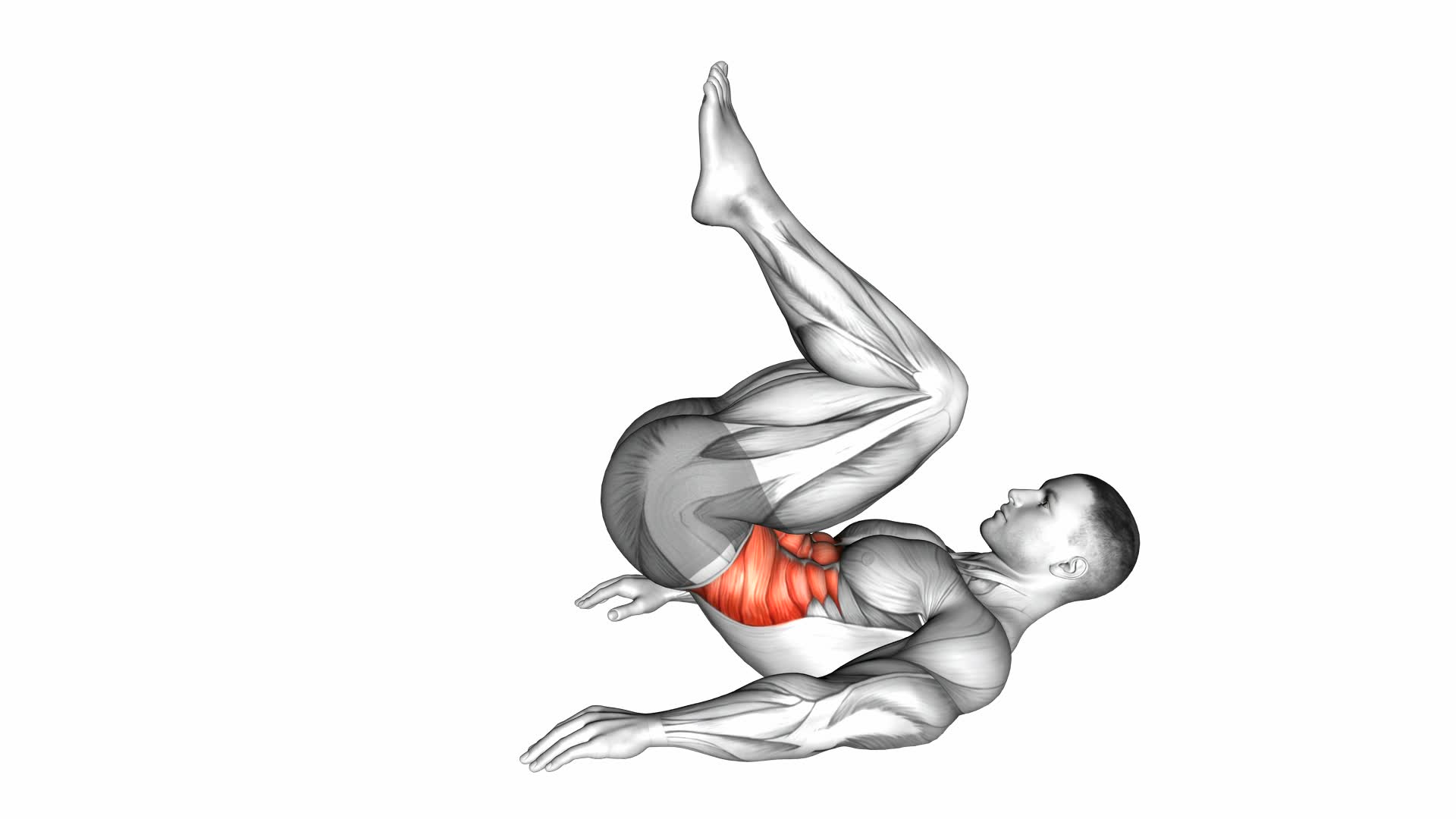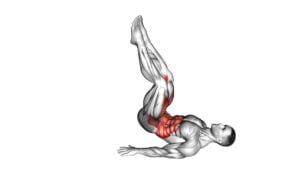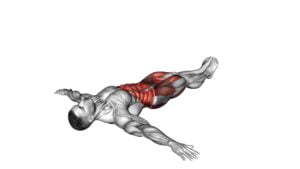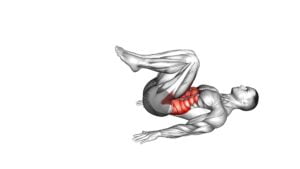Reverse Crunch – Video Exercise Guide & Tips

Looking to strengthen your core and get those abs in shape? Look no further than the reverse crunch! This highly effective exercise targets your lower abs and obliques, giving you that toned and sculpted midsection you've always wanted.
Watch This Exercise Video
In this video exercise guide, we'll show you the proper form and technique, as well as variations to challenge your core even more. Say goodbye to common mistakes and hello to maximum results with our expert tips.
Let's get crunching!
Key Takeaways
- Reverse crunches target the lower abs and obliques, strengthening abdominal muscles and improving core stability.
- Proper form and technique include keeping the lower back pressed against the floor, using the abs to lift the hips, exhaling as you lift, and controlling the descent.
- Alternative exercises such as hanging leg raises, bicycle crunches, and plank variations can provide variety in core workouts and target different muscle groups.
- To challenge the core further, variations like weighted reverse crunches, decline reverse crunches, and stability ball reverse crunches can be incorporated.
Benefits of Reverse Crunch
To maximize the effectiveness of your workout, include the reverse crunch in your routine to target your lower abs and strengthen your core. The reverse crunch is a versatile exercise that offers several modifications to suit your fitness level and goals.
One modification is to perform the exercise with your legs straight up in the air instead of bent at the knees. This variation increases the intensity and engages the lower abs even more. Another modification is to add a twist at the top of the movement, which targets the obliques and adds an extra challenge to the exercise.
If you're looking for alternatives to the reverse crunch, there are a few options you can try. The hanging leg raise is a great alternative that targets the lower abs and provides a similar challenge to the reverse crunch. Another alternative is the bicycle crunch, which not only targets the lower abs but also works the obliques and upper abs. Plank variations, such as the plank with knee tucks or plank hip dips, are also effective in strengthening the core.
Now that you're familiar with the benefits of the reverse crunch and some alternative exercises, it's important to focus on proper form and technique to ensure optimal results and prevent injury.
Proper Form and Technique
To perform the reverse crunch with proper form and technique, engage your core muscles and focus on controlled movements throughout the exercise. This will help you maximize the benefits and reduce the risk of injury. Here are some key points to keep in mind:
- Keep your lower back pressed against the floor: This ensures that you're working your abs and not straining your back.
- Use your abs to lift your hips off the floor: Avoid using momentum or swinging your legs to complete the movement.
- Exhale as you lift your hips: This helps engage your deep core muscles and promotes a more effective contraction.
- Control the descent: Slowly lower your hips back down to the starting position, resisting the urge to drop them quickly.
- Maintain a consistent pace: Avoid rushing through the exercise and focus on maintaining a steady rhythm.
Now let's address some common misconceptions about the reverse crunch. Contrary to popular belief, this exercise isn't just for beginners. It can be modified and progressed to suit different fitness levels. For those who find the standard reverse crunch challenging, modifications can include bending the knees or placing the hands under the lower back for support. On the other hand, for those looking for an extra challenge, progressions can involve adding weights or performing the exercise on an unstable surface.
Variations to Challenge Your Core
Try incorporating these three variations of the reverse crunch to challenge your core muscles. These advanced modifications will take your core workout to the next level and help you achieve even greater results.
- Weighted Reverse Crunch: If you're looking to add more resistance to your reverse crunch, try using a dumbbell or a medicine ball. Hold the weight securely between your feet as you perform the exercise. This extra weight will engage your core muscles even more and make the exercise more challenging.
- Decline Reverse Crunch: To increase the difficulty of the reverse crunch, you can perform it on a decline bench. Lie down on the bench with your head lower than your feet and anchor your feet at the top of the bench. This variation will engage your lower abs and make your core work harder.
- Stability Ball Reverse Crunch: Incorporating a stability ball into your reverse crunch can add instability, making your core muscles work harder to maintain balance. Place the stability ball between your legs and perform the reverse crunch, squeezing the ball with your thighs. This variation won't only challenge your core but also engage your inner thighs.
Common Mistakes to Avoid
Avoid these common mistakes when performing the reverse crunch to ensure you get the most out of your core workout:
- Using momentum: Don't swing your legs or use momentum to lift your hips off the ground. This takes away the focus from your core muscles and reduces the effectiveness of the exercise.
- Pulling on your neck: Avoid pulling on your neck with your hands or using your neck muscles to lift your upper body. This can strain your neck and detract from the engagement of your abdominal muscles.
- Not engaging your core: Make sure to consciously engage your core muscles throughout the exercise. This means contracting your abs and pulling your belly button towards your spine.
- Lifting your lower back off the ground: Keep your lower back pressed firmly against the ground throughout the movement. Lifting your lower back can strain your back and decrease the activation of your core muscles.
- Neglecting proper breathing: Remember to breathe properly during the exercise. Exhale as you lift your hips off the ground and inhale as you lower them back down.
By avoiding these common mistakes and focusing on proper technique, you can ensure that you're effectively targeting your core muscles during the reverse crunch.
Now, let's move on to the next section to learn some tips for maximizing your results.
Tips for Maximizing Results
To get the most out of your reverse crunches and maximize your results, focus on these key tips.
First, consider maximizing the intensity of your reverse crunches. Instead of simply going through the motions, make each rep count. Focus on engaging your core muscles and using controlled movements. Keep your abs contracted throughout the exercise and avoid using momentum to swing your legs. This will help to target the muscles more effectively and increase the intensity of the exercise.
Another tip for maximizing your results is to incorporate weights into your reverse crunches. Adding resistance can help to further challenge your abs and increase muscle activation. You can hold a dumbbell or a weight plate against your chest while performing the exercise. Start with a weight that allows you to maintain proper form and gradually increase it as you get stronger.
Remember to always listen to your body and adjust the intensity and weight according to your fitness level. As with any exercise, it's important to maintain proper form to prevent injury.
Keep these tips in mind and you'll be on your way to maximizing the results of your reverse crunches.
Frequently Asked Questions
How Often Should I Do Reverse Crunches to See Results?
To see results from reverse crunches, you need to do them regularly. The frequency of reverse crunches depends on your fitness level and goals. Generally, doing reverse crunches two to three times a week is recommended for building abs strength.
However, it's important to also incorporate other exercises to target different muscle groups. Remember to listen to your body and give yourself enough rest between workouts to avoid overtraining.
Can Reverse Crunches Help Reduce Belly Fat?
Reverse crunches can be a helpful exercise in reducing belly fat. By targeting the lower abdominal muscles, reverse crunches can strengthen and tone your core. This exercise also engages your hip flexors, which can aid in burning calories and promoting overall weight loss.
Incorporating reverse crunch variations, such as adding weights or performing bicycle kicks, can further enhance the benefits. However, it's important to remember that spot reduction isn't possible, so incorporating reverse crunches into a comprehensive fitness routine is key.
Are Reverse Crunches Suitable for Beginners?
Reverse crunches are a suitable exercise for beginners. They target your core muscles and can help strengthen them. If you're just starting out, you can modify the exercise by bending your knees and keeping your feet on the ground. This reduces the difficulty while still working your abs.
Reverse crunches provide numerous benefits for core strength and are a great addition to any workout routine. Keep practicing and you'll see progress in no time!
Can Reverse Crunches Be Done With Ankle Weights for Added Resistance?
Yes, reverse crunches can be done with ankle weights for added resistance. Using ankle weights can provide several benefits, such as increasing the intensity of the exercise and targeting the abdominal muscles even more effectively.
When using ankle weights, it's important to choose an appropriate weight based on your fitness level and strength. It's recommended to start with lighter weights and gradually increase as you become stronger.
Always ensure proper form and listen to your body to avoid injury.
Are There Any Alternative Exercises That Target the Same Muscles as Reverse Crunches?
If you're looking for alternative exercises that target the same muscles as reverse crunches, there are a few options you can try.
Plank exercises, such as the elbow plank or side plank, engage the core muscles similarly to reverse crunches.
Another exercise to consider is the bicycle crunch, which also works the abdominal muscles effectively.
These alternatives can provide similar benefits to reverse crunches and help you achieve a strong and toned core.
Conclusion
To wrap up, reverse crunches are a highly effective exercise for strengthening your core muscles. By following proper form and technique, you can target your abs and lower back while avoiding common mistakes.
To challenge yourself, try out different variations of the exercise. Remember to stay consistent and gradually increase the intensity to maximize your results.
Incorporating reverse crunches into your fitness routine will help you achieve a stronger and more stable core.

Author
Years ago, the spark of my life’s passion ignited in my mind the moment I stepped into the local gym for the first time. The inaugural bead of perspiration, the initial endeavor, the very first surge of endorphins, and a sense of pride that washed over me post-workout marked the beginning of my deep-seated interest in strength sports, fitness, and sports nutrition. This very curiosity blossomed rapidly into a profound fascination, propelling me to earn a Master’s degree in Physical Education from the Academy of Physical Education in Krakow, followed by a Sports Manager diploma from the Jagiellonian University. My journey of growth led me to gain more specialized qualifications, such as being a certified personal trainer with a focus on sports dietetics, a lifeguard, and an instructor for wellness and corrective gymnastics. Theoretical knowledge paired seamlessly with practical experience, reinforcing my belief that the transformation of individuals under my guidance was also a reflection of my personal growth. This belief holds true even today. Each day, I strive to push the boundaries and explore new realms. These realms gently elevate me to greater heights. The unique combination of passion for my field and the continuous quest for growth fuels my drive to break new ground.







